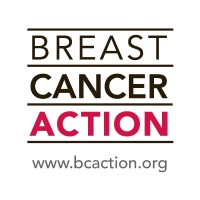
Breast Cancer Action
Breast Cancer Action (BCAction) is a national grassroots education and advocacy organization. Our mission is to achieve health justice for all women at risk of and living with breast cancer. As the watchdog of the breast cancer movement, we educate, organize, and take action for systemic change in three areas: -Breast Cancer Screening, Diagnosis, and Treatment -Root Causes of Breast Cancer -Pink Ribbon Marketing and Culture BCAction believes that breast cancer is a social justice issue and a public health crisis. Individual action alone, whether in terms of lifestyle or behavioral choices, is not sufficient to tackle the root causes of the breast cancer epidemic. We focus on systemic interventions that will address the root causes of the disease and produce broad public health benefits. These benefits will ensure that fewer women develop breast cancer and die from breast cancer and no community bears a disproportionate burden of diagnosis or death from this disease. As a matter of policy, we do not accept funding from any company that profits from or contributes to the cause of cancer. This policy allows us to always put patients before profits.






